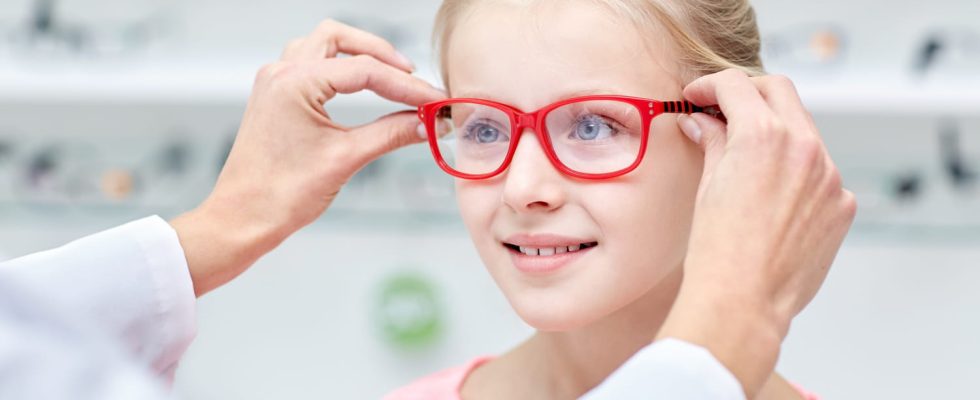Vision is fragile, especially in toddlers: it is the last sense to develop. How to diagnose vision problems in children? What solutions to treat it in time?
In France, nearly1 in 10 children experience vision problems. Knowing how to spot the first signs of a visual anomaly in a child is therefore fundamental. In effect, early detection of visual problems in very young children reduces the risk of developing visual disorders. “The most important thing is to avoid theamblyopiai.e. a difference in visual acuity between the two eyes: the brain has chosen to work with only one eye and the other has not developed“, explains Dr. Lucie Sigronde, ophthalmologist specializing in pediatrics. If visual acuity does not mature until around the age of 5, the child’s sight must be monitored from the first months: the earlier a disorder such as strabismus or amblyopia is detectedthe better the chances of correcting it.
“Eyesight development is a process that lasts several years“, explains the ophthalmologist. At birth, the baby blinks in bright light, which testifies to his visual sensitivity. He can stare at faces at very close range. In the first months, his eyes will have difficulty working together, and the infant will not always be able to focus on an object very close or very far from him. It’s only after three months that eye pursuit movements appear. At five months, the child will begin to coordinate eye, head and hand. “At 3 or 4 years old, her visual acuity reaches 8/10th, explains the professional. She will reach 10/10th at 5 years approximately“, she adds.
“A wandering gaze or a strabismus should lead to consultation”
What are the signs of visual impairment in children?
Before three months, the baby has difficulty seeing, and it is difficult to spot an anomaly. “Nevertheless, strabismus, in general, should alert parentssays the professional. From four months, strabismus, eyes that squint or go to the side should lead to go to an ophthalmologist as soon as possible“. In general, lack of interest in visual stimuli, wandering gaze or even a child pressing his eyes should alert parents. When the child grows, additional signs should challenge: from six months, a child who bumps, falls, stumbles, squints, grimaces, closes one eye to the sun or is indifferent to those around him may have vision problems. Another sign should alert parents: a white glint in the eye of the child, which is seen above all in the photos. This can reveal a very rare and very serious pathology, called retinoblastoma eye tumor.
When to bring your child to an ophthalmologist?
According to the French Society of Pediatrics (SFP), personal and family history should be taken into account. Must consult an ophthalmologist regularly:
- THE premature babies,
- babies with a chromosomal abnormality,
- babies with a family history of strabismus,
- babies with a family history of severe and early myopia, amblyopia or astigmatism
“For others, there are often screenings organized in schoolsand can go to the ophthalmologist if the pediatrician has any doubtsexplains Lucie Sigronde. But if a parent sees one of the signs listed above, it is better to consult“.
“When we receive a child, we do an orthoptic assessment complete, we are looking for strabismuseye mobility is checkedwhen they are small we do tests called ‘baby vision’“, explains the professional. An important step is called “refraction under cycloplegia“, which allows professionals to have the refractive power of the child’s eye with reliable values, and to have an idea of the refractive disorder. “Then, we finish the examination by ensuring that the cornea and lens are very clear, and that there are no problems with the optic nerves“, she adds.
What solutions in children in case of visual disturbances?
If a child is nearsighted, farsighted or astigmatic with a difference between the two eyes (and in general one who sees a little more blurred than the other), it is necessary to quickly correct this with eyeglasses to prevent the problem from getting worse. If the glasses are not enough, you must put on an eye patch to stimulate the weaker eye. When the treatment is done well, the rehabilitation is done perfectly. The risk is not to take charge of this in time, and that the child makes amblyopia : the brain will only work with one eye. But this is corrected well before three years, and can still be taken care of before six years. After this age, it becomes final.
From what age can you wear glasses?
“There is no age to wear glasses“, insists the ophthalmologist. A child can therefore have glasses without any problem at two or three months, or even less. “If you have a child who has a permanent strabismus from birth, or who is too farsighted for his age, the sooner he has glasses, the better it will be for him.“, she concludes.
Thank you to Dr. Lucie Sigronde, ophthalmologist specializing in pediatrics.
